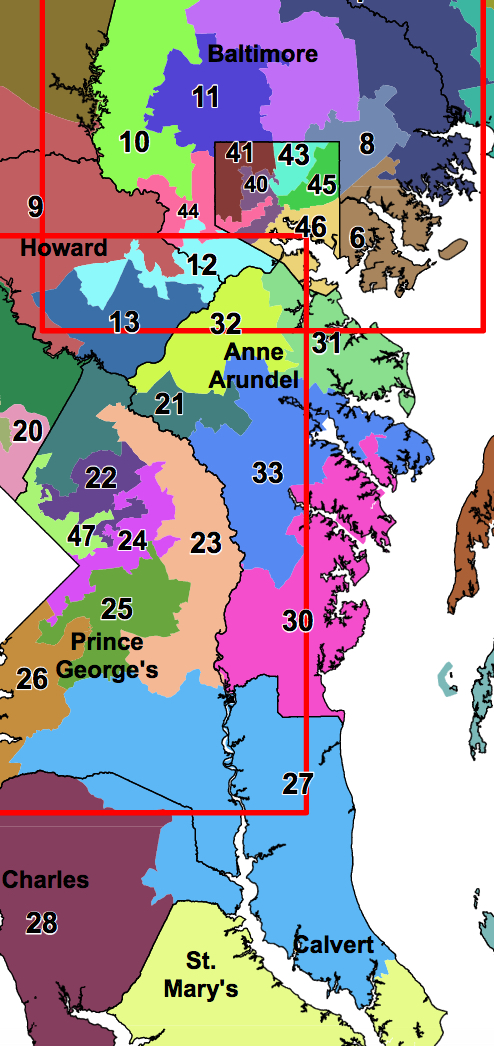Part I discussed ratings for safe and toss-up seats in the Maryland Senate. Today, 7S focuses on the six Lean and Likely Democratic districts. All are currently held by incumbent Democrats.
Lean Democratic
District 3 (Frederick County). Sen. Ron Young had a real scare in 2014, winning just 50.8% of the vote after defeating incumbent Alex Mooney with 51.1% in 2010. Mooney has since fled to West Virginia where he is now a U.S. Representative.
This part of Frederick has been trending Democratic. Clinton carried D3 by 8. Hogan won by 15, a good margin but less impressive than in several districts held by Democrats in Anne Arundel and Baltimore. As this district has the best Democratic territory in Frederick, Young ought to be able to win a third term.
But Frederick has been hotly contested between the two parties of late and this former Frederick Mayor has sometimes been a controversial figure. My current expectations remain for the GOP to have another go at Young but fall short, though they will force Democrats to scramble to retain the seat.
Likely Democratic
See the map at the bottom of the post for the locations of the five Likely Democratic districts.
District 8 (Baltimore County). Sen. Kathy Klausmeier won an impressive victory in 2014. Though her district went for Hogan by 36 points, she not only won but took 61.2% of the vote. In 2016, Hogan’s impressive margin evaporated as Trump carried D8 by seven-tenths of one percent.
This is an interesting district because, though the incumbent has demonstrated popularity, it remains marginal turf. If Republicans want to make gains, they will have to look here, even if Klausmeier is clearly no easy mark. The district could become competitive with the right Republican candidate and favorable political winds.
District 11 (Baltimore County). Sen. Bobby Zirkin was unopposed for reelection last time around, so what is he doing on this list? Zirkin represents a cross-pressured district that supported Hogan by 14 points even as it then went for Clinton by 24 points.
Zirkin is an active legislator who champions several popular, easy-to-explain causes, such as stronger anti-domestic violence legislation. Nonetheless, if Maryland’s political climate turns against Democrats, this seat could be a surprise domino to fall. The district bears watching even if Zirkin should be in good shape.
District 12 (Howard and Baltimore Counties). Another cross-pressured district, D12 went for Hogan by 11 but Clinton by 17. Budget and Taxation Committee Chair Ed Kasemeyer won reelection with a convincing, albeit a tad lower than Klausmeier, margin of 58.6%.
Kasemeyer has an impressive electoral history (59% in 2014, 59% in 2010, 62% in 2006, 63% in 2002, 57% in 1998, 51% in 1994, 54% in 1986) that will make it difficult for Republicans to break through in increasingly Democratic Howard.
Howard has shown itself willing to vote for particular sorts of Republicans, including County Executive Allan Kittleman, who is liberal on social questions, and Gov. Larry Hogan, who relentlessly ignores them. Can the Republicans find one to challenge Kasemeyer or win the open seat should he choose to retire?
District 27 (Southern Maryland). Mike Miller entered the House of Delegates in 1971, the Senate in 1975 and became the Senate President in 1987, which makes him the longest serving legislative body leader in American history. Sen. Miller has led the Senate for so long that when I interviewed him over the telephone for my college senior thesis in the late 1980s, he was already Senate President.
The Senate President represents a politically diverse district that includes big chunks of Calvert and southeastern Prince George’s Counties as well as smaller bits of Charles and St. Mary’s. The Calvert portion of the district is much more Republican than the portions in Charles or Prince George’s.
Republicans would love to defeat this pillar of the Democratic Party. While he attracts complaints of being too conservative from the left, he fights very hard for members of his caucus, raising a lot of money and directing broader organizational efforts to retain a robust Democratic Senate majority.
This district is also far from totally hostile territory. While Clinton won it by 5 points in 2016, Hogan also carried it by 6 points in 2014. This divergence is a lot smaller than many Maryland legislative districts and is suggestive of tighter partisan loyalties, especially among its sizable African-American minority.
Republicans have not come close to defeating Miller. He won 63% in 2014, 75% in 2010, 70% in 2006, 72% in 2002, 69% in 1998, 68% in 1994, 84% in 1990, and 82% in 1986. (The State Board of Elections has not put the stone tablets with earlier election results online yet.) Despite receiving his lowest percentage since at least the 1980s in 2014, my guess is that Sen. Miller is not going to be beat. Still, the turf is marginal and remains Likely Democratic.
District 32 (Anne Arundel). Yet another cross-pressured district that bears a more than passing resemblance to its nearby counterparts in Baltimore and Howard Counties, this district went for Hogan by 17 but for Clinton by 12.
Moderate Sen. Ed DeGrange would seemingly be a good fit for this district. Except in these highly partisan times, some will argue that an outspoken liberal would do more to stir the troops. Like others listed here, he possesses real electoral experience, winning his seat by 59% in 2014, 60% in 2010, 61% in 2006, 59% in 2002, and 52% in 1998.
The remarkable consistency since his first reelection does not look like the record of someone about to lose his seat. Nevertheless, if Republicans are to make gains, they will look to Anne Arundel and to this district along with District 30.


